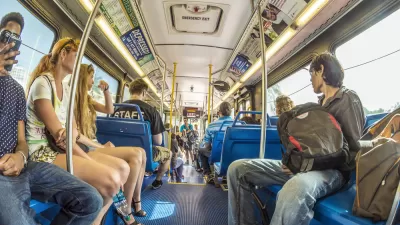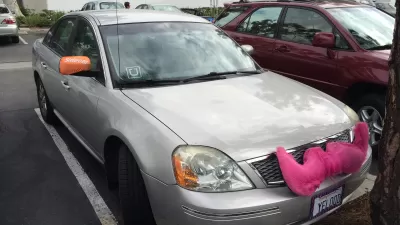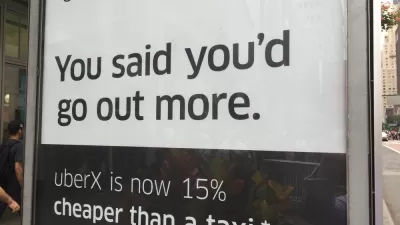While evidence mounts that Uber and Lyft are stealing rides from public transit, there's still a chance for ride-hailing apps to do more to help than hurt congestion. The key: using ride-hailing apps to carpool.

Studies of New York and other cities, including by our colleagues at UC Davis, suggest that Uber, Lyft, and other app-based car services are increasing congestion by facilitating a shift away from mass transit. That shift is to be expected. App-based car services offer users many of the same advantages as mass transit (the ability to avoid parking, the opportunity to travel without a driver’s license, etc.) at an increased level of comfort and convenience, while remaining relatively affordable. Of course Uber and Lyft will skim travelers from transit.
Though app-based car services may increase congestion in this limited regard, there is even greater—yet largely ignored—potential for such services to reduce net congestion by facilitating multi-passenger pooling. So far, pooling has not caught on widely. Since the 1970s, hundreds of billions of dollars have been invested into building a web of carpool lanes in most major U.S. cities. Yet carpooling has steadily declined from about 20% of commute trips in the 1970s to less than 10% now (see figure). Today, each car on the road in the United States contains an average of only 1.6 passengers, and the majority of the time vehicles are occupied only by the driver.

Nevertheless, pooling remains the transportation mode of choice for a significant fraction of commuters. In 2013 (the most recent year for which data are available), 9.4% of workers commuted by carpooling: almost twice the percentage of workers who commuted by public transit. App-based car services could vastly increase this market share. The popularity of services such as Uber, Lyft, and Via proves that people will pool as long as it is easy, convenient, and reliable. And when people pool, everyone wins. Sharing a ride with just one other passenger effectively halves all the costs and negative externalities of driving, including congestion. This is particularly important with respect to work commuters, since jobs tend to be located in cities and other concentrated areas where parking and road space is at a premium. App-based pooling can also increase equity by expanding transportation options for those who can’t afford to drive alone and may not be well served by transit. Finally, pooling can reduce noise, local air pollution, and greenhouse-gas emissions by providing more transportation service per mile of vehicle travel. (The role of pooling as the most important innovation for achieving sustainable transportation is a central theme of the forthcoming Island Press book authored by Dan Sperling and nine other leaders in the field of new mobility, Three Revolutions: Steering Automated, Shared, and Electric Vehicles to a Better Future.)
Given limited funding availability for improving mass transit as well as general public resistance toward implementing congestion pricing, public officials should not just allow app-based pooling systems—they should champion them as one of the most feasible ways to tackle traffic congestion. Unfortunately, most policymakers have been slow to do so. The city of Chicago, for instance, recently imposed a $1-per-ride fee on all ridesharing companies amid concerns that such companies were costing the city money in the form of lost transit fares, parking fees, and other transportation-related sources of revenue. A major problem with Chicago's fee is that it fails to differentiate between single-rider trips, which provide no extra societal benefits, and pooled trips, which do.
Next up is New York, where Governor Andrew Cuomo is evaluating options for reducing traffic, including a possible ridesharing tax. This complex process is exposing disagreements between New York State and New York City, and among different boroughs in the city. Yet the process also presents an opportunity to set important and innovative policy. Governor Cuomo—and all other decision-makers in similar positions—would be well-advised to consider the substantial role that app-based pooling can play in reducing congestion and improving quality of life for all. Indeed, a diverse coalition of transportation experts and stakeholders recently expressed precisely this view in an open letter [pdf] to the governor. Regulation of app-based car services may be justifiable in some cases, but such regulations must be carefully designed to favor pooling and avoid throwing the baby out with the bathwater.
Dan Sperling is founding director of the Institute of Transportation Studies at the University of California, Davis and professor of Civil Engineering and Environmental Science and Policy. He also is a member of the influential California Air Resources Board and is recognized as an international expert on transportation technology assessment, energy and environmental aspects of transportation, and transportation policy. Dr. Sperling’s book Three Revolutions is officially publishing on March 1 and is currently available for order from Island Press and pre-order from Amazon.
Austin Brown is executive director of the Policy Institute for Energy, the Environment, and the Economy at UC Davis. In this role, he builds strong connections between the research and policy communities at the local, state, and national levels with a focus on clean energy and sustainable transportation. Prior to joining UC Davis in June 2017, Dr. Brown spent nine years in Washington, D.C., working for the Department of Energy and as assistant director for Clean Energy and Transportation at the White House Office of Science and Technology Policy under the Obama Administration.

Alabama: Trump Terminates Settlements for Black Communities Harmed By Raw Sewage
Trump deemed the landmark civil rights agreement “illegal DEI and environmental justice policy.”

Planetizen Federal Action Tracker
A weekly monitor of how Trump’s orders and actions are impacting planners and planning in America.

The 120 Year Old Tiny Home Villages That Sheltered San Francisco’s Earthquake Refugees
More than a century ago, San Francisco mobilized to house thousands of residents displaced by the 1906 earthquake. Could their strategy offer a model for the present?

LA’s Tree Emergency Goes Beyond Vandalism
After a vandal destroyed dozens of downtown LA trees, Mayor Karen Bass vowed to replace them. Days later, she slashed the city’s tree budget.

Sacramento Leads Nation With Bus-Mounted Bike Lane Enforcement Cameras
The city is the first to use its bus-mounted traffic enforcement system to cite drivers who park or drive in bike lanes.

Seattle Voters Approve Social Housing Referendum
Voters approved a corporate tax to fund the city’s housing authority despite an opposition campaign funded by Amazon and Microsoft.
Urban Design for Planners 1: Software Tools
This six-course series explores essential urban design concepts using open source software and equips planners with the tools they need to participate fully in the urban design process.
Planning for Universal Design
Learn the tools for implementing Universal Design in planning regulations.
Ada County Highway District
Clanton & Associates, Inc.
Jessamine County Fiscal Court
Institute for Housing and Urban Development Studies (IHS)
City of Grandview
Harvard GSD Executive Education
Toledo-Lucas County Plan Commissions
Salt Lake City
NYU Wagner Graduate School of Public Service





























